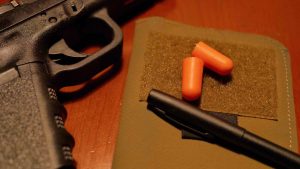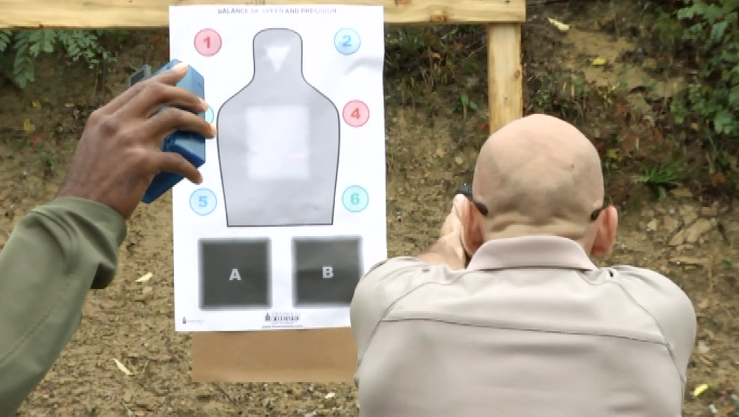When you invest in defensive firearm training you are typically making a significant investment. The most obvious cost is your tuition for class, but there are other costs of defensive firearms training that you may not have considered such as your ammunition, meals away from home, travel expenses, and maybe most important, your time. These expenses are significant so it only makes sense that with the total cost of your defensive training you should have an expectation to get something of significant value in return.
There are a lot of things that you can do to get the most out of your defensive shooting class, but one of the easiest things you can do to get the biggest return is to invest in electronic hearing protection.
 The problem with learning on a live fire range:
The problem with learning on a live fire range:
A live fire shooting range can be a tough place to learn. The volume level of gunfire is unsafe for your hearing and without hearing protection your hearing will be damaged with each and every gun shot.
So, we wear hearing protection to protect our valuable sense of hearing.
Hearing protection complicates things because it can make verbal communication difficult. It’s a certainty that your instructor will want to communicate verbally with you during class and it is likely that while you are wearing your hearing protection you will have a more difficult time understanding the verbal communication of your instructor. The fact that your instructor will likely spend a good amount of time standing behind you (because you have a gun in your hand) makes the communication even more difficult to deal with. With your instructor to the rear, you won’t have the ability to supplement your poor hearing with lip reading.
Learning is all about effective and efficient communication and in the name of safety you intentionally make communication and learning more difficult.
Electronic hearing protection helps you learn.
This is where an investment in electronic hearing protection might makes sense. Standard hearing protection keeps your ears safe by insulating your ear drums from the loud sound of gunfire. Electronic hearing protection insulates your ears just the same, but microphones pick up and amplify the sounds around you, like your instructor’s voice, so that you can clearly hear what is happening around you. At the same time, the fancy electronic wizardry filters out any loud noises like gun fire.
Electronic hearing protection restores your ability to hear what is happening around you to a large degree. This means you are more likely to hear range commands, explanations of concepts and principles, and the feedback and cues that you need for efficient communication from your instructor. You will hear more while you are wearing sound deadening hearing protection, even when you are firing your gun.
Plain and simple, electronic ears help you to hear all of the things that you are paying to hear from your instructor. You will learn more, you will enjoy class more, and you will get a larger return for your investment in training by adding electronic hearing protection to your range gear.
You can read about even more advantages of electronic hearing protection and some specific recommendations on brands of electronic ears here.
Get the most from your electronic hearing protection:
I’m a firm believer in making sure that my hearing is safe when I’m on the range and you should feel the same. The problem with most electronic hearing (and most other muffs) is that they leave a bit to be desired when it comes to protection. The NRR (noise reduction rating) of most electronic muffs ranges between 19 and 29. Depending on which formula you buy into even a set of muffs with a NRR of 30 are only going to reduce the impact of a gunshot by about 15 dB. This means you are still exposed to between 125 dB and 175 dB of sound.
 A set of ear plugs under your muffs will add another 5 dB of protection and that can be a big difference especially if you are training indoors or with louder rifles. The problem with adding another layer of protection is that you make communication even more difficult.
A set of ear plugs under your muffs will add another 5 dB of protection and that can be a big difference especially if you are training indoors or with louder rifles. The problem with adding another layer of protection is that you make communication even more difficult.
With electronic ears this isn’t an issue. Just turn them up. Remember, the hearing pro is actually amplifying the hearing safe sounds around you. You can turn the volume up so that voice commands are easily able to get past your plugs while the sound of gunshots are blocked out by both the muffs and the plugs. My favorite pair of electronic ears are the Pro Ears Pro-Tac Gold. They amplify hearing safe sounds 8x but I swear they go to 11!
Probably the biggest advantage of doubling up on hearing protection is that even when your over the ear muffs are compromised in some way your hearing is still protected. Simply shouldering a rifle can move muffs enough to break the seal of the ear cup and I’ve been involved in dynamic training where my hearing protection has become dislodged because of dynamic movement. When you double up one hearing pro, this isn’t an issue.
Final thoughts:
We know that every time our ears are exposed to gunfire without adequate hearing protection our hearing is damaged in a cumulative and permanent manner. At the same time wearing hearing protection can make communication and learning more difficult by muffling the sounds we need to hear to learn.
Although it seems like a difficult situation to resolve, the solutions is actually quite simple and the answer is electronic hearing protection. Electronic ear pro protects your hearing and amplifies the sounds you are paying to hear in a defensive firearms course. When combined with plugs, you create a comfortable and redundant system of hearing protection that minimizes interfering with your learning.
Before your next live fire training course invest in quality electronic hearing protection. It will be well worth your while when it comes to your safety and the important return on your investment in your training.
-Paul Carlson
[Editors’s Note: While I agree with the author that Electronic Protection can make hearing an instructor on the range easier under most conditions, I have found that many people have problems achieving the proper position in rifle (and sometimes pistol) courses with ear muffs of any kind. Muffs can also be knocked off while training in/around vehicles or in other close quarters. I much prefer my students where plugs… there are electronic plugs available, but they are relatively expensive. Your hearing safety is important, but so is training relatistically… chose your protective gear carefully. -RJP)
The post Is Electronic Hearing Protection Right for You? appeared first on Personal Defense Network.
WATCH THE VIDEO BELOW & DEFEND YOURSELF





 Why Use A Coin Toss In Defensive Shooting Practice?
Why Use A Coin Toss In Defensive Shooting Practice? Once everything is in place, take your trusty quarter out of your pocket and give it a toss. If you see a heads, drop the coin and place multiple hits into the “Hâ€. If you see a tails, well, shot the “Tâ€.
Once everything is in place, take your trusty quarter out of your pocket and give it a toss. If you see a heads, drop the coin and place multiple hits into the “Hâ€. If you see a tails, well, shot the “Tâ€. Once you have spent some forcing decisions on what threats you need to shoot, take the drill to the next level. Set up your two targets at two different distances or set up targets of two different sizes. This forces you to make more difficult decisions. In addition to deciding what threat you need to shoot, you now need to vary the level of skill that you apply to get the hits as quickly as you can. A very practical defensive shooting skill set to develop.<
Once you have spent some forcing decisions on what threats you need to shoot, take the drill to the next level. Set up your two targets at two different distances or set up targets of two different sizes. This forces you to make more difficult decisions. In addition to deciding what threat you need to shoot, you now need to vary the level of skill that you apply to get the hits as quickly as you can. A very practical defensive shooting skill set to develop.<